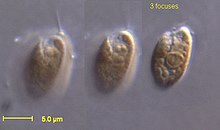
Back مخفيات النبت Arabic Cryptophyta BE Skrytěnky Czech Cryptophyta Danish Κρυπτόφυτα Greek Cryptophyta Spanish Krüptofüüdid ET Nielulevät Finnish Cryptophyta French Criptifít GA
| Cryptomonads | |
|---|---|

| |
| Rhodomonas salina | |
| Scientific classification | |
| Domain: | Eukaryota |
| Clade: | Diaphoretickes |
| Clade: | CAM |
| Clade: | Pancryptista |
| Phylum: | Cryptista |
| Subphylum: | Rollomonadia |
| Superclass: | Cryptomonada Cavalier-Smith, 2004 stat. nov. 2015[1] |
| Classes & orders[1] | |
The cryptomonads (or cryptophytes)[2] are a group of algae,[3] most of which have plastids. They are traditionally considered a division of algae among phycologists, under the name of Cryptophyta.[4] They are common in freshwater, and also occur in marine and brackish habitats. Each cell is around 10–50 μm in size and flattened in shape, with an anterior groove or pocket. At the edge of the pocket there are typically two slightly unequal flagella. Some may exhibit mixotrophy.[5] They are classified as clade Cryptomonada, which is divided into two classes: heterotrophic Goniomonadea and phototrophic Cryptophyceae. The two groups are united under three shared morphological characteristics: presence of a periplast, ejectisomes with secondary scroll, and mitochondrial cristae with flat tubules.[6] Genetic studies as early as 1994 also supported the hypothesis that Goniomonas was sister to Cryptophyceae.[7] A study in 2018 found strong evidence that the common ancestor of Cryptomonada was an autotrophic protist.[8]
- ^ a b Cavalier-Smith, Thomas (2018). "Kingdom Chromista and its eight phyla: A new synthesis emphasising periplastid protein targeting, cytoskeletal and periplastid evolution, and ancient divergences". Protoplasma. 255: 297–357. doi:10.1007/S00709-017-1147-3. PMC 5756292. PMID 28875267.
- ^ Barnes, Richard Stephen Kent (2001). The Invertebrates: A Synthesis. Wiley-Blackwell. p. 41. ISBN 978-0-632-04761-1.
- ^ Khan H, Archibald JM (May 2008). "Lateral transfer of introns in the cryptophyte plastid genome". Nucleic Acids Res. 36 (9): 3043–53. doi:10.1093/nar/gkn095. PMC 2396441. PMID 18397952.
- ^ Okamoto, N.; Inouye, I. (2005). "The Katablepharids are a Distant Sister Group of the Cryptophyta: A Proposal for Katablepharidophyta Divisio Nova/Kathablepharida Phylum Novum Based on SSU rDNA and Beta-Tubulin Phylogeny". Protist. 156 (2): 163–179. doi:10.1016/j.protis.2004.12.003. PMID 16171184.
- ^ "Cryptophyta - the cryptomonads". Archived from the original on 2011-06-10. Retrieved 2009-06-02.
- ^ Cavalier-Smith, Thomas (2004). Organelles, Genomes, and Eukaryote Phylogeny. pp. 87–88.
- ^ McFadden, Gilson, & Hill (1994), "Goniomonas: rRNA sequences indicate that this phagotrophic flagellate is a close relative of the host component of cryptomonads", European Journal of Phycology, 29 (1): 29–32, doi:10.1080/09670269400650451
{{citation}}: CS1 maint: multiple names: authors list (link) - ^ Cenci (2018), "Nuclear genome sequence of the plastid-lacking cryptomonad Goniomonas avonlea provides insights into the evolution of secondary plastids", BMC Biology, 16 (1): 137, doi:10.1186/s12915-018-0593-5, PMC 6260743, PMID 30482201